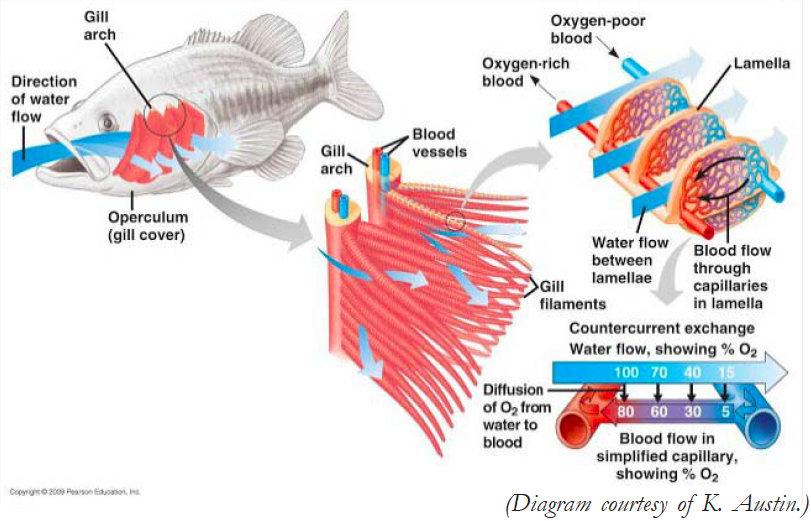Written by Ken Austin, Certified Koi Keeper, Koi Organisation International
Gills are important to the health and well-being of your Koi. Anything that undermines their efficiency is likely to be harmful to the health of the Koi. While gills may be broadly considered equivalent to your lungs, they serve multiple functions, to include:
- Gaseous exchange where dissolved oxygen in the water diffuses into the blood stream and carbon dioxide in the blood stream diffuses out into the water.
- Ammonia produced by the digestion of protein is expelled from the blood stream into the water via the gills.
- Osmoregulation, a process for maintaining the proper balance of sodium, calcium and other solutes and ions in the Koi's body.
Gills are uniquely structured to perform this vital exchange of metabolic wastes and  oxygen. The surface area of each gill filament is increased by out-foldings, called lamellae (la-mel-eye, rhymes with camel + eye). These give each filament the appearance of a Christmas tree, with branches running up each side of the trunk. The lamellae are delicate, comprising a single layer of cells covering a network of blood capillaries. That single layer of cells is the membrane that separates the pond water from the blood, yet allows the diffusion of gasses to pass from an area of high concentration to an area of low concentration. For example, the blood stream will have a higher concentration of ammonia than the pond water. This difference in concentration is the driving force that moves ammonia molecules out of the blood stream, across the membrane, and into the water. The pond water has a higher concentration of oxygen, which drives oxygen molecules into the blood stream.
oxygen. The surface area of each gill filament is increased by out-foldings, called lamellae (la-mel-eye, rhymes with camel + eye). These give each filament the appearance of a Christmas tree, with branches running up each side of the trunk. The lamellae are delicate, comprising a single layer of cells covering a network of blood capillaries. That single layer of cells is the membrane that separates the pond water from the blood, yet allows the diffusion of gasses to pass from an area of high concentration to an area of low concentration. For example, the blood stream will have a higher concentration of ammonia than the pond water. This difference in concentration is the driving force that moves ammonia molecules out of the blood stream, across the membrane, and into the water. The pond water has a higher concentration of oxygen, which drives oxygen molecules into the blood stream.
There are two common ways the gill structure can be damaged:
- They can be physically attacked (eaten away), usually by bacteria, fungi or parasites. This loss of gill surface area reduces the amount of gas exchange.
- Hyperplasia, where the gill cells thicken and the mucus layer thickens, in response to an irritant. This thickening slows the gas diffusion rate, which also reduces the amount of gas exchange. The irritant can be any chemical you have added to the water, any chlorine that was not neutralized, or pH changes in the pond water.
In either case, the amount of oxygen taken into the body is reduced (known as suffocation), and the blood stream concentrations of toxic carbon dioxide and ammonia increase. The results can be deadly.
Poor water quality is often a primary cause of gill problems and can also cause increases in parasite populations. An initial, seemingly minor problem can quickly escalate as secondary infections, with irreversible damage, which ultimately leads to the death of the Koi. Maintain good water quality to prevent gill problems.
The behavior of your Koi are the first indications of gill problems, such as:
- Koi may sometimes avoid using pectoral fins.
- Rubbing or flashing are indications of an irritant.
- Koi may be less active and less ready to take food.
A firm diagnosis requires mucus samples or tissue samples taken from the gills and examined under a microscope.
As a rule of thumb, it is better to err on the side of caution if a gill problem is suspected. A 10 to 15 minute, well-aerated salt bath at 10 grams of salt per liter of water (about 8 teaspoons per gallon) will remove excess mucus and act against most parasites. It may be necessary to repeat this the following day, if there is no improvement. If this does not resolve the problem, then a physical examination and the examination of gill tissue under the microscope is in order. Waiting and hoping for things to improve on their own just never seems to work out very well.
Worried about your Koi's gill health? Here are some product suggestions that may help you:
Parasite and Fungal Treatments- Broad Spectrum Disease Treatment; Pimafix
Bacterial Infection Treatment- Melafix
Testing and Salt- Master Liquid Test Kit; KH and GH Test Kit; pH Buffer; Salt
And Don't forget Dechlorinator for water changes- DetoMax+

